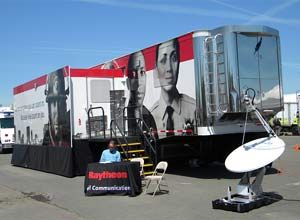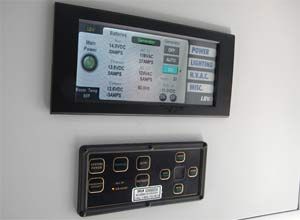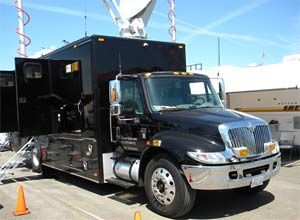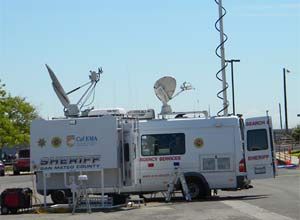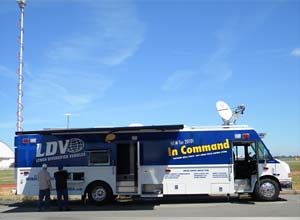The second annual California MCC Rally provided a valuable opportunity to see and discuss first-hand some of the latest trends in both operations and design of mobile command/communications units.
I spoke to one captain who said that deployments of his agency’s rig have decreased significantly in recent years. He attributed that to more agencies getting their own interoperability capabilities, so the big rigs such as his county’s aren’t used as much anymore. This in turn suggests that the need for such large units may not be as great as before, since there are now so many MCCs in a given region.
Multiplexing and IP
While the shape and size of most large MCCs hasn’t changed, the rally showcased a number of innovations in equipment design and capability.
I toured LDV‘s demo unit and found that the company has replaced the multitude of switches controlling lights, HVAC and other functions with a small, computer-based multiplex control system that reduces training requirements and simplifies the operation of MCCs.
“Internet-based interoperability systems are now available from several companies that eliminate the need for one department to own or have provisions for a radio from every area agency,” said Cheryl Stang, LDV’s marketing and public relations director.
“Each department or agency now can place their system on the network, and talk groups can be established instantly by the necessary departments. This easily allows expansion of interoperability to other local establishments such as universities, hospitals and stadiums/parks. If an event takes place on the local campus, one operator can have the ability to connect fire, police and medical responders and make necessary announcements on the campus PA system, all from one workstation.”
Raytheon has enhanced its venerable ACU-1000 interoperability hardware system, found in many MCCs, and created the ACU-2000 IP, a modular, completely scalable and field-configurable system that connects disparate communication systems over an IP network. Rather than just providing interoperability between radio systems, the ACU-2000 IP can connect SIP (Session Initiation Protocol, an IP-based signaling protocol) VoIP devices, as well as radio systems at multiple sites across a distributed IP network.
“The direction moving forward appears to be to make more equipment IP-based or IP-integrated,” said LDV’s Stang. “In addition to radio entering this field, video and phone are now regularly being shared over Internet. As more equipment makes the move to IP integration, operator flexibility and sharing capabilities grow.”
Another advance in interoperability systems has been in making them smaller and more portable. The RIOS Tactical, from Sytech, also built into many modern MCCs, integrates the company’s Radio Interoperability System (RIOS) into a capable stand-alone interoperability package for emergency deployment applications. The all-inclusive RIOS Tactical improves response time by eliminating external PC controllers and connectivity errors.
Bigger might not be best
Some agency personnel suggested that the now-familiar, large and heavily-equipped MCCs may not necessarily be as functional as smaller units that separate command and communications components.
One example that turned heads at the California Rally was the small truck and van consist from the San Mateo County Sheriff’s Department, which had received a Mobile Interoperability Gateway Unit (MIGU), one of six that the California Emergency Management Agency (Cal EMA) deployed to each of its mutual aid regions.
Developed by Cal EMA and funded through federal homeland security grants, the MIGUs include such communications features as an Operational Area Satellite Information System (OASIS) Satellite Transportable Earth Station, Internet capability, videoconferencing, an audio gateway switch for patching radio equipment, high-frequency and VHF/UHF radios, and more.
The MIGU is carried on a pick-up truck to a scene, then is lifted off to rest on the ground, allowing the pick-up to carry on with other tasks. San Mateo County is running theirs in concert with their small, cargo van–sized communications vehicle.
One captain I spoke to looked out at the MIGU through the window of his agency’s 40-foot motorhome-styled MCC. “That is much more portable,” he said. “You can put it on a trailer or sling-load it in and have your interoperability capabilities right there when you need it, rather than waiting for the deployment of a large vehicle coming from some distance away.”
“In addition to traditional, larger command center units, LDV has experienced an increase in number of requests for smaller platforms, including Sprinter vans,” said Stang. “The reason agencies buy smaller is they do not have the desired funding, or they already have a large unit, so they want smaller units that can be deployed for smaller situations. This also allows them to handle multiple situations that happen at the same time.
“Another reason for smaller is because the unit is used for communications rather than command and communications, so they omit the conference room and even the bathroom and/or galley.
“Price differences between a Sprinter and a 40-foot truck can be deceiving, however. A lot of what drives the final cost of a mobile command center is the technology hardware that is included. We recently delivered two Sprinter command centers that cost nearly $500,000 each.”
Refurbished MCCs
Another idea to defray the increasing expense of a large modern MCC is found with a new company launched to answer an unmet need in the mobile command center market: quality, refurbished vehicles that agencies on a tight budget could afford.
“Traditionally, MCCs can cost $500,000 or more,” said David Ronsen, a 20-year veteran and former Type III Incident Commander with CalFire and now president of Meridian Specialty Vehicles, Bozeman, Mont. “We realized that by building our vehicles on refurbished chassis with new components, we could shave off a huge portion of those costs.
“Take a brand new MCC and one of our refurbished models: They feature the same finished materials and the same high-quality components and technologies from the same vendors. People simply can’t tell the difference between our refurbished MCC and a brand-new one from one of the ‘big boys.’ A Meridian performs just as well; it just costs up to 70 percent less.”
Corporate support
As more private companies take on corporate responsibility functions to contribute to disaster support, more MCC capabilities are being brought to incidents by the private sector.
For example, Bay Area–based Cisco Systems has a full time Tactical Operations Team which regularly responds, free of any costs, to local, national and international disasters, bringing a wealth of technological infrastructure in its state-of-the-art Network Emergency Response Vehicle (NERV). Devoid of huge company logos, the NERV is deployed by Cisco to support the public-sector response and aid in critical infrastructure restoration.
“Those things are corporate social responsibility functions for Cisco,” said Cisco’s Rakesh Bharania. “It’s the right thing for Cisco to do, for our customers and for the community. Business wise, I get to take Cisco’s latest and greatest technologies into the field and battle test them, and this is how CISCO validates its technology.”
Cisco also provides a consultancy role to government agencies. The NERV, a NIMS Type II–compliant MCC, recently served as a model for a pair of MCCs deployed by the California Highway Patrol. While the NERV also serves to demonstrate the company’s technological assets, it comes equipped for operation, not with demo models or in-development hardware.
“The technology is real,” said Bharania. “What we do for our sales team is bring credibility to what they then offer our customers.”


